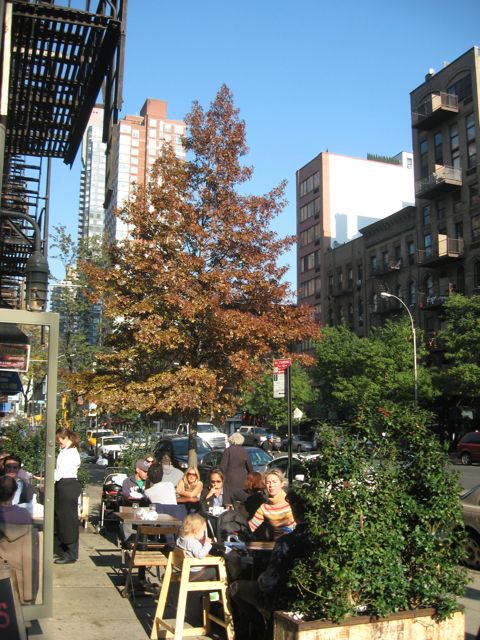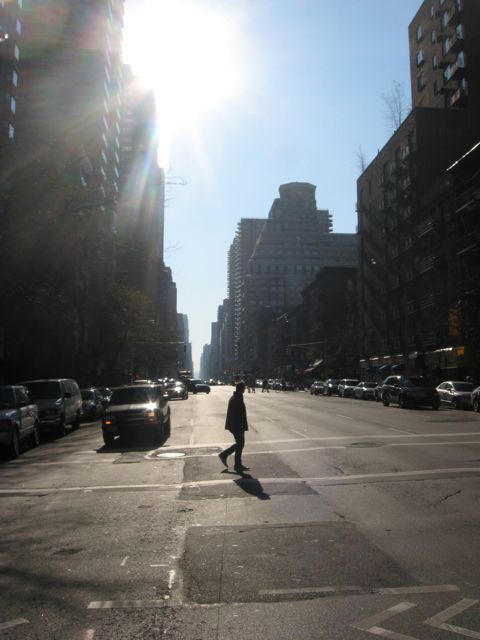
OUR SUNDAY WALK FROM 102ND AND LEXINGTON AVE TO 77TH STREET AND YORK AVE Â (FOR THE BEST CROISSANTS)
New York has famous trees, notably the American Elms of Central Park, found along the Mall, these trees are spared no expense, live in a posh area of town and are often photographed and admired. Â Being American Elms, these cherished trees represent an age of the country lost through time and disease; The central Park Elm allee is a surviving remnant of the American main street, which at one time had a cathedral-like row of Elms gracing the town. Â To see this Central Park row in person has the wow effect that was desired in these trees and an illustration of what was achieved in American towns before the blight.
The Elm allee is the aesthetic ideal of another time, one that was killed-off by the imported Dutch-Elm disease and has never been fully re-created in the following eras.  The American Elms of Central Park stand today as a living museum of the ideal American urban streetscape  of a long by-gone era.
We are going to examine the post Elm tree period leading right up to the present in Manhattan’s Upper East Side, where we will find some magnificent re-creations of the cathedral of trees, as well as many bleak reminders of how far of a departure was made from the urban arboreal ideal  in the contemporary landscape, as pictured above.
These trees are not famous, and they are for the most part, experimental and barely able to survive some of the most harsh conditions possible, many of them diseased and stressed. However, these trees are loved by New Yorkers, and there is a re-newed appreciation for trees in general, from private development to urban planning, street trees are coming back into fashion!
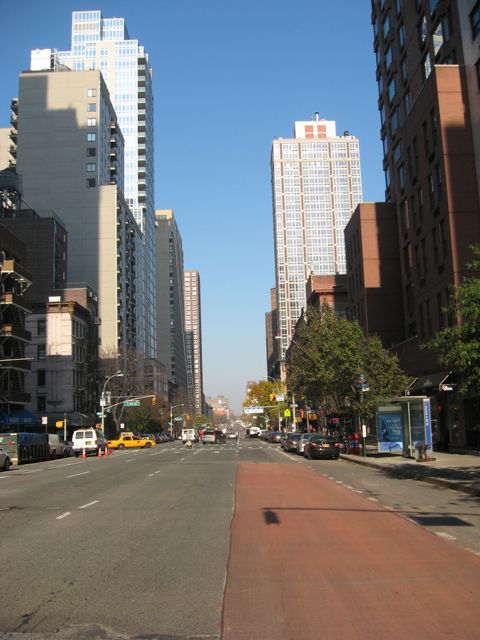
Above, the scene before us, architecturally, is a victim of the lack of taste in the twentieth century as well as the either completely lacking or incoherent public policy towards tree planting in the era. Â Like in many places, this part of Manhattan was at the wrong place at the wrong time.
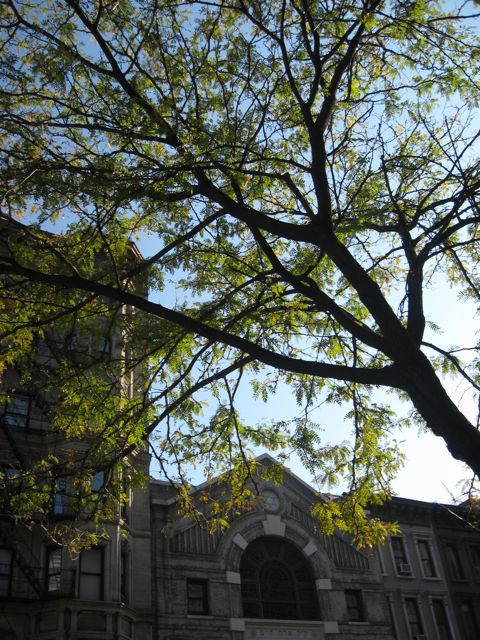
Into the 100s along Lexington Ave, we find ourselves in a well preserved neighborhood architecturally, and we are able to read the landscape from the point of view of the intentions of one era- late 19th century brownstones and apartment buildings. There are few trees, but we are seeing mature Honey-Locusts like the one pictured above, and recently planted White Oaks on some blocks.
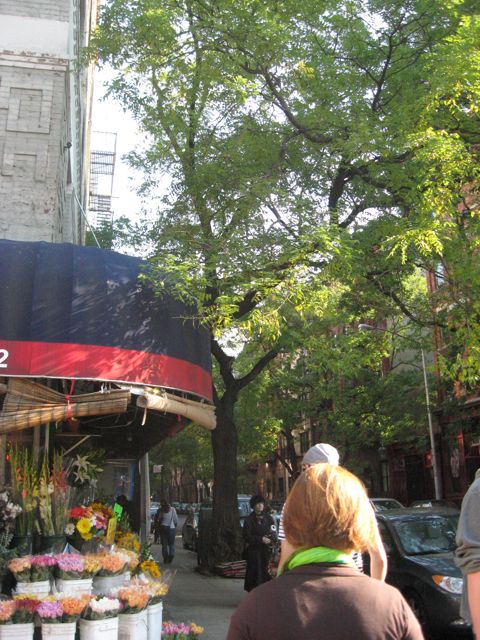
The Honey Locust has been planted throughout the Upper East side of Manhattan, and is the most common street tree found.
Below, while the architecture is unfortunate save a couple of elegant curving walls, those involved with the planning stage of this structural outburst had good intentions and planted a row of Honey Locusts that create the effect of the Elm allee of America’s Main street. The result is at least a block that is possibly walkable, even at this bare minimum of aesthetic acceptability. This row of trees gives charm to what would otherwise be a completely unacceptable landscape.
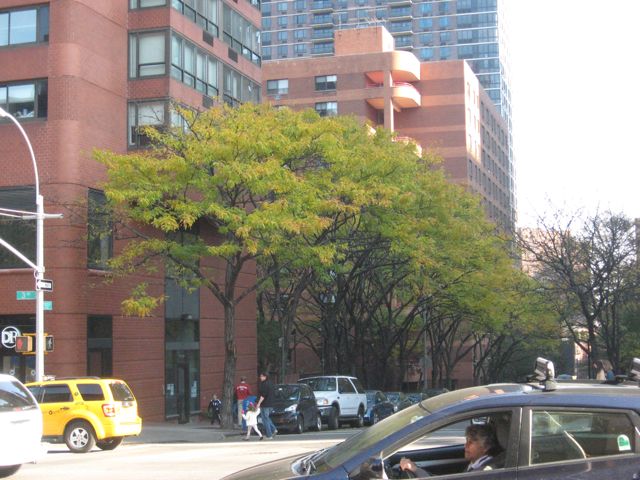
While the street trees above give life to a barren landscape, they add a pleasant dimension to the late 19th century urban landscape in contemporary use pictured below.
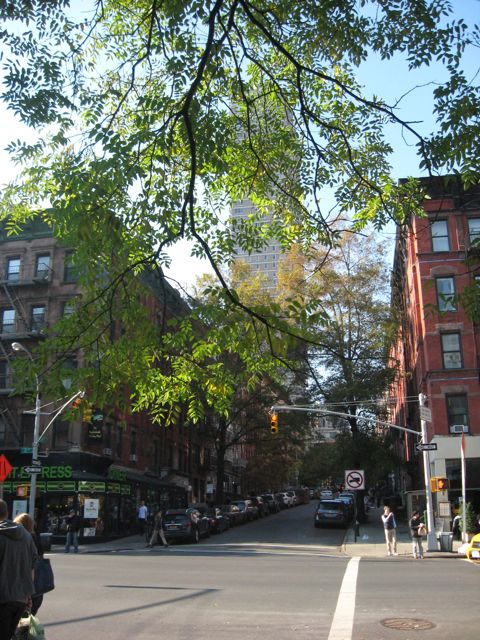
The apartments above, with the stores at the street level create a comfortable city, one that is idealized today in the present movement towards  a ‘new’ urbanization. The mature Honey-Locusts add another sweet layer to this modern ideal of the charming old city, re-energized and full of amenities; trees especially!

Ginko biloba
The Ginko tree can be found often enough on the streets of the Upper East Side. Note the distinctive branching habit of this tree, very noticeable in this specimen. The tree appears as if it is waving at you with its many, many arms. The unusual fan-shaped leaves turn a bright yellow in the fall.
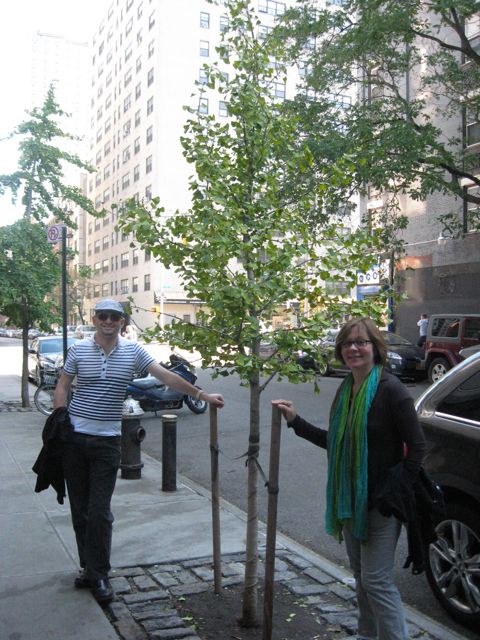
Still a favorite, Ginko continues to be planted. On this street, this young specimen is planted alongside older ones, presumably to maintain the continuity of the species on the block. Isabelle poses with our host Paul.
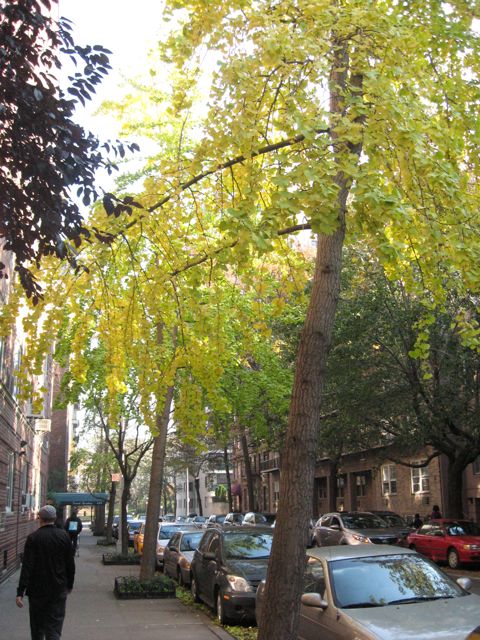
Here the Ginko trees are displaying their magnificence and street-tree savvy, creating for us the perfect fall day.
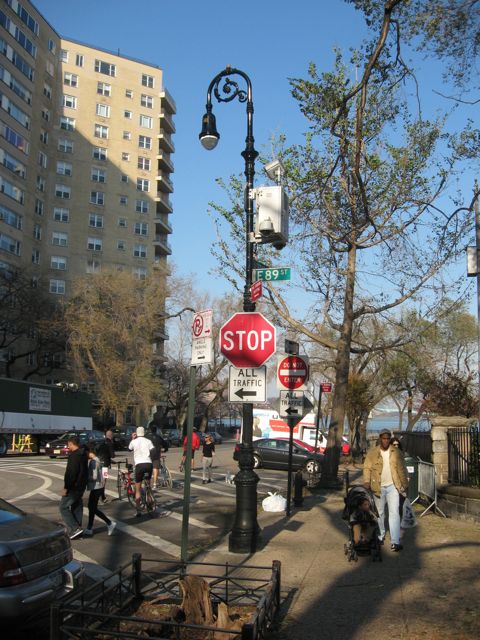
One has died on this row of Ginkos alongside Carl Shurz park. Notice how much the trees contribute to this urban scene. The East River adds even more to the naturalistic setting creating a sense of place to the concrete and asphalt grid of the city.
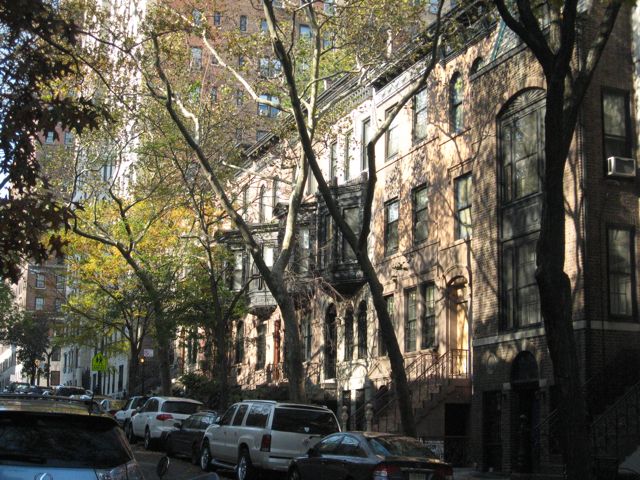
This next scene is a blend of mature Oaks and London Plane trees on this block of elegant brownstone rowhouses. The City of New York has done a great job in maintaining these trees over the years, keeping them pruned in a pleasing sustainable manner. The trees and the houses appear comfortable together, especially how the trees have been pruned so they lean away from them, so they are in no way threatening.
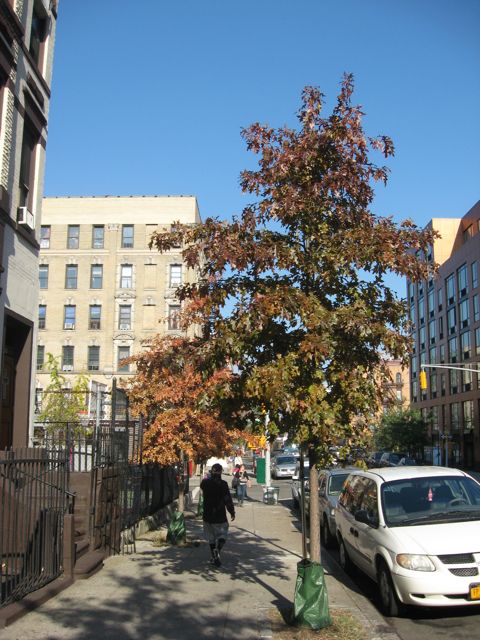
The oak tree has become increasingly common in recent times. On this block, somebody is very concerned about the trees, and has placed watering bags around them. Â Now is the time to remove the bags, so mold does not develop around the tree. The best approach with using these bags is to zip them around the tree, fill them up and remove them the next day after they have slowly watered the tree for ten hours.
- Upper East Side Street Trees, New York City
Here a young oak tree is contributing to the renewed urban landscape: here can be seen that cities, trees and shrubs can be a very pleasant combination, and an economical one at that, as this restaurant exemplifies.
Below, the Oak trees here provide a much needed buffer between the apartment building and the highway.
- Upper East Side Street Trees, New York City                         Â
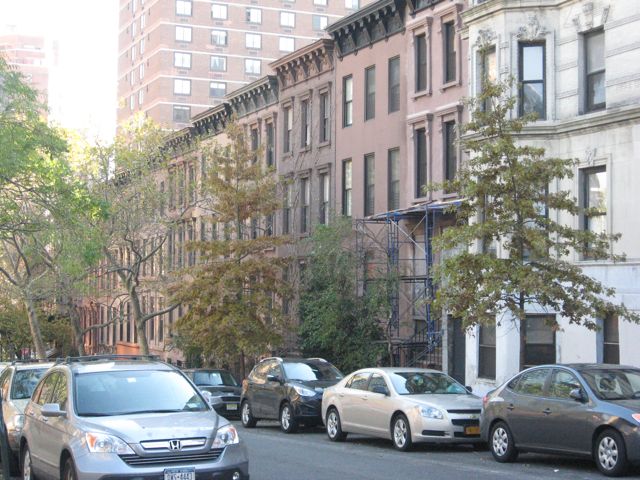
On this block of Brownstones, the oaks are replacing the London Planes.
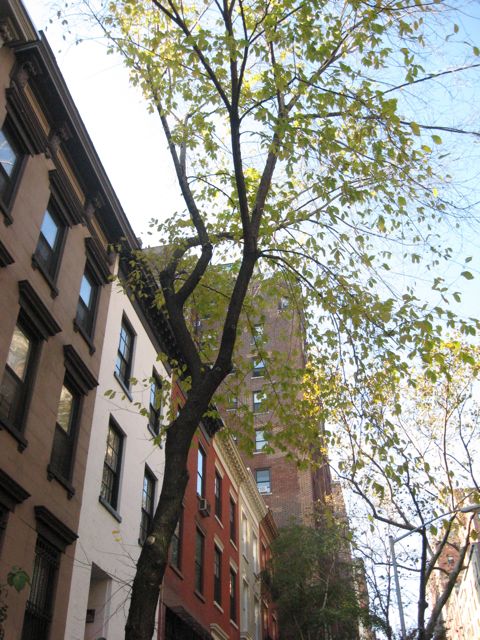
Here is an American Elm, growing not from the curbside, but from the tiny garden in front of the Brownstone at the far left.
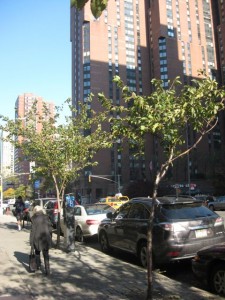
We encountered these Japanese cherry trees on our walk. These are very popular trees because of their blossoms.
On some streets, we find the scale of the trees with the brownstones very pleasing; the houses and the trees work together aesthetically to create an urban atmosphere that is settling.
The towering structures of housing that have become such an integral part of the contemporary global urban landscape clash with the urban ideal of scaled down 18th and 19th century buildings, renovated and updated, set in a landscape of trees and small parks.
The tall towers rise to the occasion, and fulfill the demand for populating these cities, but they fail miserably on fulfilling the ideal. We are now starting to see green roofs and green walls pop up here and there, and the wealthiest can have small trees on their rooftop terraces.
But now that we have settled on the ideal of trees and cities being together, that this is a winning combination economically, that people will pay for this, there needs to be creative solutions right away.
The picture to the left of the sad-looking Japanese Cherry trees illustrates the need for cities to adapt to the growing demand for ‘livability’. Â Street trees are in demand. Maybe tall buildings can be designed with allees of trees on upper floors, using specimens that are small and can occupy pots. Street life could become elevated, with commerce on upper floors of buildings as well.
If cities are going to become the most desirable places to live, than they should be fitted with the most appropriate trees in as much space as possible, to create a place that is comfortable and truly fitting to the region of the city. Trees native to the region of the city would fall into the category of the most appropriate. These are the trees that will survive the climate the best, as well as be supporting to the habitat of native species of insects and birds that will add charm and the sense of place to the urban landscape. When thinking of native habitat, imagine crickets and fireflies, katydids and hummingbirds, just for starters, all in an urban neighborhood!
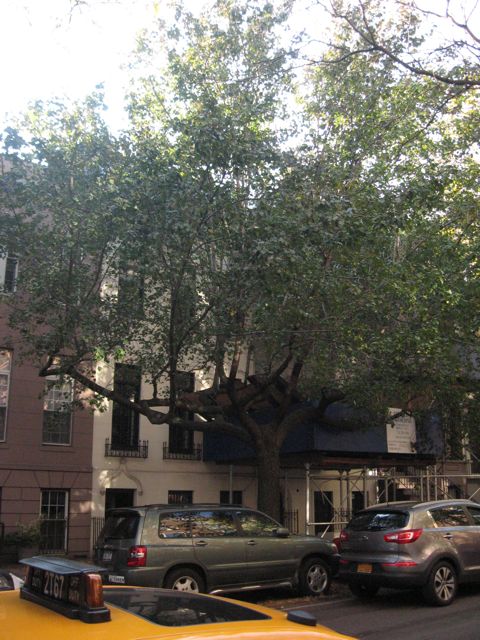
The Callery pear, a most unfortunate New York Street tree, native to East Asia, this tree has become problematic, with weak branches and a tendency to reseed itself in natural areas and has now become an invasive pest as well, this tree has not helped the cause of street tree appreciation. Cultivars such as the ‘Cleveland select’ have become recently fashionable because they do not have the problem of breaking branches and offer a more compact shape. These trees bloom for a short period in the Spring, and they hold their waxy leaves until very late in the fall.
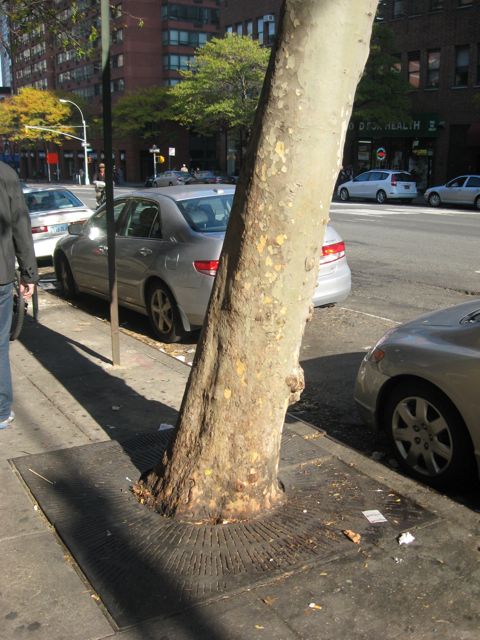
In the picture above, we can see what a street tree must endure during its life; this London Plane has survived so far, with the metal grate protecting it. The grate is designed to be cut with a metal grinder at certain intervals of the tree’s growth. This grate is ready to be cut for the next  iteration of its life.
Street trees live a tough life and are subject to rigorous conditions: Low light, road salt, scraped off bark, dog poop, cat poop, poor soil conditions and reduced moisture from the asphalt and concrete surroundings,
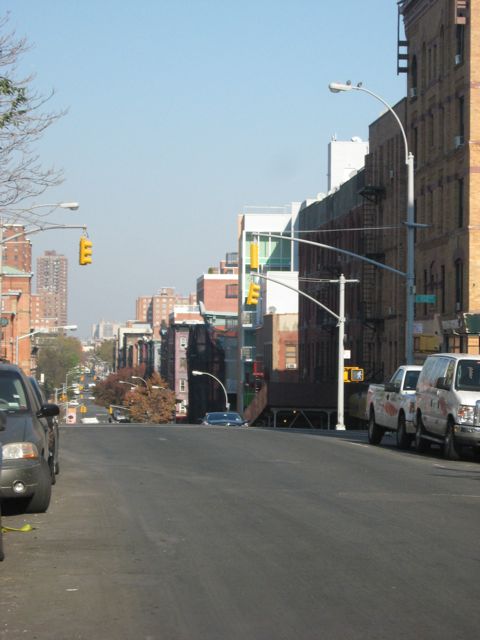
As pictured above, Manhattan has an exemplary quality to show the distance of itself, as we see looking north on Lexington ave  at 101st towards 125th street. Looking off towards this horizon, we see trees off in the blocks ahead and our thoughts are directed towards this distance, where the sky meets the tops of the trees. Like the cities they inhabit, street trees are planted, growing, dying, falling and re-emerging or just emerging for the first time in a new incarnation as a street tree.
Street trees are very much the product of fashions and trends, many of which are no longer planted as frequently, and the final results are yet to come. Many trees become susceptible to disease and blight, and when this happens, woe is the block with all of the same species on it. Some trees like the Callery pear were just a mistake to begin with. As the trendy street trees of the recent past get older, we will be learning more of their problematic issues.
Female Ginkos drop some odorific fruits that could be classified as a problem by some and are harvested by others. This is still a time-tested tree with a degree of status in the realm of street trees. New ones such as the native Redbud and Serviceberry are on the horizon. New York City recommends that these trees be planted with a single stem, shunning the shrub-like tendencies of these two species for planting along the street.
New York City is fully aware of the problematic ones, and discourages them. Because of the Emerald Ash Borer, some trees are not recommended for planting at all in most boroughs.
New York City has launched an initiative to plant  one million trees by 2017.
Over 8000 trees were downed by Hurricane Sandy.
There is a trend towards diversity and trees that are native, and this is the result of many years of mistakes. The grand Allee of matching trees is being replaced with a smarter and a wizened, world weary approach to urban tree assemblages: More native, more hardy in harsh conditions, diverse in species and the least expensive to maintain.



